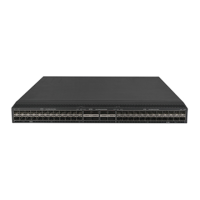10
In Ethernet interface view, if you do not specify an agent type, the command sets the
operating mode for the nearest bridge agent.
{ In Layer 2/Layer 3 aggregate interface view:
lldp agent { nearest-customer | nearest-nontpmr } admin-status
{ disable | rx | tx | txrx }
In aggregate interface view, you can set the operating mode only for the nearest customer
bridge agent and nearest non-TPMR bridge agent.
{ In IRF physical interface view:
lldp admin-status { disable | rx | tx | txrx }
In IRF physical interface view, you can set the operating mode only for the nearest bridge
agent.
By default:
{ The nearest bridge agent operates in TxRx mode.
{ The nearest customer bridge agent and nearest non-TPMR bridge agent operate in Disable
mode.
Setting the LLDP reinitialization delay
About LLDP reinitialization delay
When the LLDP operating mode changes on a port, the port initializes the protocol state machines
after an LLDP reinitialization delay. By adjusting the delay, you can avoid frequent initializations
caused by frequent changes to the LLDP operating mode on a port.
Procedure
1. Enter system view.
system-view
2. Set the LLDP reinitialization delay.
lldp timer reinit-delay delay
The default LLDP reinitialization delay is 2 seconds.
Configuring the advertisable TLVs
1. Enter system view.
system-view
2. Enter interface view.
interface interface-type interface-number
3. Configure the advertisable TLVs.
{ In Layer 2 Ethernet interface view:
lldp tlv-enable { basic-tlv { all | port-description |
system-capability | system-description | system-name |
management-address-tlv [ ipv6 ] [ ip-address | interface loopback
interface-number ] } | dot1-tlv { all | port-vlan-id |
link-aggregation | dcbx | protocol-vlan-id [ vlan-id ] | vlan-name
[ vlan-id ] | management-vid [ mvlan-id ] } | dot3-tlv { all |
link-aggregation | mac-physic | max-frame-size | power } | med-tlv
{ all | capability | inventory | network-policy [ vlan-id ] |
power-over-ethernet | location-id { civic-address device-type

